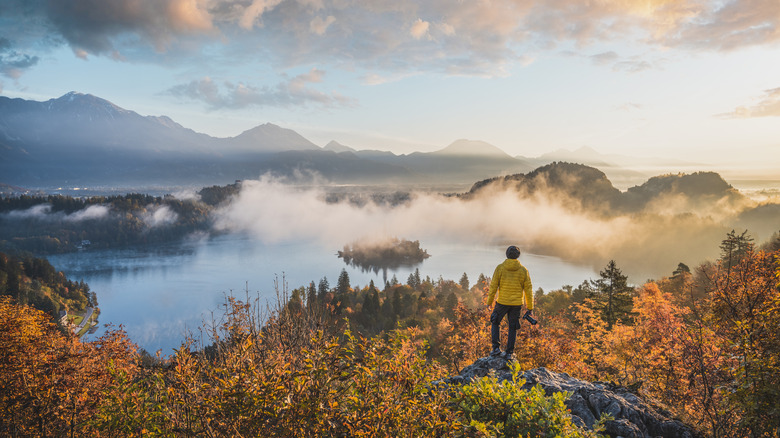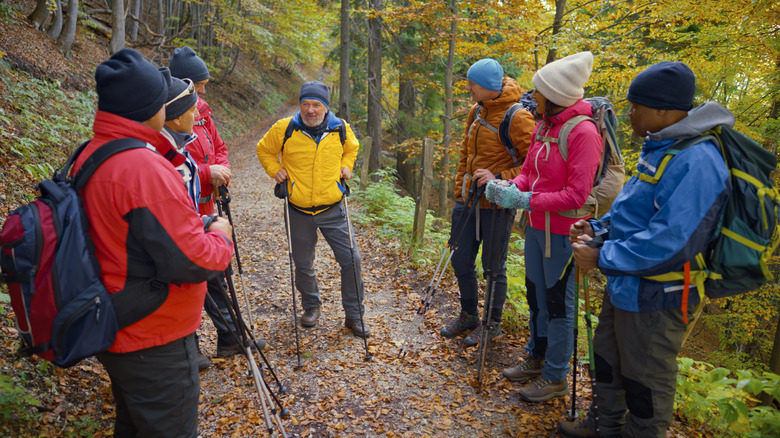Stay Warm And Comfortable During A Fall Hike With These Genius Layering Tips
We may receive a commission on purchases made from links.
Fall is one of the most popular times for a variety of outdoor activities, including hiking. Breathtaking views of fall foliage is one of the main reasons people like hitting the trail during autumn. However, you must consider the potentially unpredictable temperature fluctuations. While the milder temperatures can make for a more pleasant hiking experience, the fall weather can also go from just right to downright uncomfortable in a hurry, as autumn is a time of frequent weather changes.
Given the weather transitions that occur as fall fades to winter, there are a few things to know before heading out on a fall hike. In fact, knowing what to wear on your hiking trip is just as important as picking the perfect spot for your autumn adventure. While many people have heard the term "layering" when it comes to proper dress for outdoor activities, not everyone knows how to layer properly or efficiently. However, it is easy to stay warm and comfortable during a fall hike if you utilize a three-layer system consisting of a base, middle, and outer layers.
Under layers for fall hiking
The beauty of this three-layer system is that the layers can be added or removed to adjust to changing weather conditions throughout the day. The primary purpose of the base layer is to wick away moisture. Most modern base layers are made from nylon or polyester, although natural materials such as merino wool or silk are also effective. Base layers also provide a foundation for insulation and are available in light, mid, and heavy weight options. Lightweight, such as the 32 Degree Lightweight Base Layer Crew Top, is considered best for moderate or cool temperatures, and is the most common choice for fall hiking. Midweight is good for colder temperatures, so it may be a good choice in late fall or in northern regions. Keep in mind, the base layer is the one layer that will always be on, so don't overdo it.
Middle layers are meant for insulation. The best insulation layers are efficient at retaining or trapping your body heat. There are a wide variety of garments for middle layers. Keep in mind, the mid-layer doesn't necessarily need to just consist of one item. It is not uncommon to use a primary mid-layer item like the Columbia Steens Mountain Full Zip Fleece Jacket beneath a vest or puffer jacket. These layers are meant to be added and/or removed throughout the day as temperatures change or you become more or less active. So, the other major consideration for these middle layers is packability, as overly bulky items will be difficult to stuff in your pack when they aren't being worn.
Outer layers and accessories for fall hiking
While the base and middle layers are the primary clothing you will be wearing on most fall hikes, you also need to be prepared with the proper outer layers and accessories. These items are particularly important if the weather turns rainy, windy, or unexpectedly cold.
Outer layers are meant to protect from rain and wind. This layer is also sometimes referred to as a shell layer, as it consists of shell garments that are windproof and/or waterproof. They may or may not be insulated and may or may not be breathable. Again, packability is at a premium, as this layer will typically reside in your pack until needed. Simple shells like the Outdoor Ventures Lightweight Rain Jacket Pullover are common choices for mild fall weather outings, while jackets such as The North Face Antora Waterproof Jacket, which is also breathable and windproof, is a good pick for conditions that require this layer to be worn throughout the hike.
In addition to these three layers, hikers looking to be prepared for any fall weather should also include lightweight gloves in their packs, along with neck gaiters, and sunglasses. Hats are another critical component. Wide-brimmed hats or caps are fine for mild fall weather. However, when temperatures turn a bit more chilly, wool caps or beanies are better choices.


